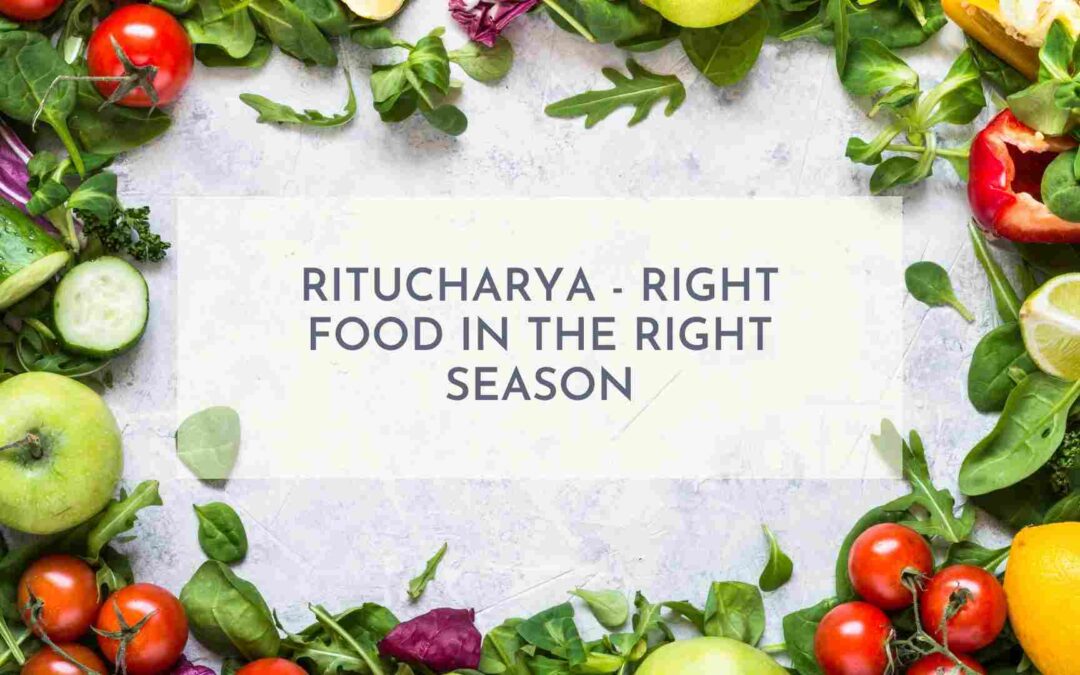Food, as we all know, is very essential but are we eating the right way?
Do you eat all varieties of food in all the seasons?
For most of them, the answer is YES!!!
With the advent of agricultural technology and the seeding process, all sorts of grains, pulses, fruits, and vegetables are available across the year in the majority parts of the country.
But is this good for your health?
How many of us know that there is different food for different seasons?
Yes !! We are talking about the Ritucharya / Seasonal regime.
We have 6 seasons/ ritus as per Ayurveda. Ayurveda, the age-old science of life, has always emphasized maintaining health and preventing diseases by following proper diet and lifestyle regimens rather than treatment and cure of the diseases.
This article is to the readers who believe food is the best medicine. Food is vitalizing and is the fuel for the 30+ trillion cells of our body.
Every season there is a certain kind of fuel the cells need in order to work efficiently as per the climate and environment.
Let’s dig in to explore !!!
What is Ritucharya according to Ayurveda?
The word Ritucharya is made up of two words Ritu means seasons and Charya means regimen ( do’s and don’t). The importance of a healthy lifestyle in this day and age is more than ever.
What is Ritus?
As mentioned earlier Ritu means season and we have 6 Ritu in India each spanning 2 months.
- Hemant Ritu – Mid November to Mid January
- Sisira Ritu – Mid January to Mid March
- Vasanta Ritu – Mid March to Mid May
- Greeshma Ritu – Mid May to Mid July
- Varsha Ritu – Mid July to Mid September
- Sharad Ritu – Mid September to Mid November
How to maintain a healthy lifestyle through ritucharya?

Let us see each Ritu and Ritucharya with more details!
Hemant Ritucharya ( Late Autumn )
Characteristics :
Mid-November to mid-January is considered as Hemanta (late autumn) Ritu. Blow of cold winds starts and chillness is felt. The strength of a person remains on highest grade and digestive fire is very powerful in this ritu.
Diet regimen:
One should use unctuous, sweet, sour, and salty foods. Among cereals and pulses, new rice, flour preparations, green gram, Various meats, fats, milk and milk products, sugarcane products, fermented foods, sesame to be included in the diet.
Cold and dry foods are to be avoided. Intake of cold drinks is also to be avoided.
Lifestyle:
Exercise, body and head massage, use of warm water, heavy clothing, residing in warm places is recommended.
Know more about different kinds of exercises FitnessAndMore.
Exposure to strong and cold wind, the habit of day sleep are to be avoided.
Sisira Ritucharya ( Winter )
Characteristics:
Mid-January to mid-March (approximately) is considered as Shishira Ritu (winter). During this season, the environment remains cold, along with the cold wind. The strength of the person becomes less yet the digestive fire is at a higher state in this ritu.
Diet regimen:
Foods with a predominant taste of amla (sour) are favored. Cereals and pulses, wheat/gram flour products, new rice, corn, and other grains and pulses are recommended. The diet should contain ginger, garlic, sugarcane products, and milk and milk products.
Foods having pungent, bitter, astringent predominant Rasa are to be avoided. Light and Cold foods are advised to be prohibited.
Lifestyle:
Massage with oil/ powder/ paste, bathing with lukewarm water, exposure to sunlight, wearing warm clothes are mentioned to follow.
Vata aggravating lifestyle like exposure to cold wind, excessive walking, sleep at late night, are to be avoided.
Vasanta Ritucharya (Spring )
Characteristics:
The approximate time from mid-March to mid-May is considered as This season is considered as the season of flowering and origin of new leaves. The strength of the person remains to a medium degree. Digestive fire in this ritu is moderate.
Diet regimen:
Easily digestible food should be consumed. Old barley, wheat, rice, and other cereals are recommended. Lentil and other pulses can be consumed. It is necessary to consume food that tastes bitter, pungent, and astringent. Honey, in addition to these, should be included in the diet. Meats that are easier to digest can be consumed.
Foods that are hard to digest are to be avoided. Those which are cold, viscous, heavy, sweet should not be preferred. New grains, curd, cold drinks, and so on, are also to be prohibited.
Lifestyle:
Warm water to be used for bathing purposes and detoxification of the body as per ayurvedic procedure is preferred.
Day-sleep is to be strictly avoided during this season.
Greeshma Ritucharya (Summer)
Characteristics:
Greeshma (summer) season runs from mid-May until mid-July (roughly). Extreme heat and unhealthful wind are frequent in the environment. The river beds dry up, and the plants appear to be dead. Digestive fire will be mild in this ritu.
Diet regimen:
Rice, lentils, and other light-digesting foods with sweet, cold ( cold is not ice cream, pitta pacifying food is called cold) and liquid should be consumed. It is recommended that you drink plenty of water and other liquids such as cold water, buttermilk, fruit juices, meat soups, mango juice, and churned curd with pepper.
Hot food should not be consumed. Pungent and sour foods to be avoided.
Lifestyle :
Staying in cool settings, massaging the body with sandalwood and other aromatic pastes, wearing light clothing, and napping during the day are all beneficial. The cooling moon rays with the air can be enjoyed at night. Excessive activity or strenuous work should be avoided, and alcoholic beverages should be avoided.
Varsha Ritucharya ( Monsoon)
Characteristics:
Varsha Ritu is observed from mid-July to mid-September. The sky is cloudy throughout this season, and rains occur without thunderstorms. Water is flowing in the ponds, rivers, and other bodies of water. The strength of the person again becomes less and Digestive Fire is not strong.
Diet regimen:
Foods having sour and salty tastes should be consumed. Among cereals, old barley, rice, wheat, etc., are advised. Intake of boiled water is preferred.
The foods, which are heavy and hard to digest, like meat, etc., are prohibited.
Lifestyle:
Getting wet in rain, day-sleep, exercise, hard work, exposure to wind are to be prohibited.
Sharad Ritucharya (Autumn)
Characteristics :
Sharat Ritu is observed from mid-September through mid-November (autumn). The Sun shines brightly during this period, the sky remains clear with occasional white clouds, and the earth is covered with wet mud. The strength of the person remains medium and digestive fire increases in this ritu.
Diet regimen:
Easy to digest, food with sweet, bitter taste and foods with the properties to pacify the pitta are advised.
Foods that are hot, bitter, sweet, or astringent should be avoided. Foods like fat, oils, seafood, curds, and other dairy products should also be avoided during this season.
Lifestyle :
The habit of eating food, only when there is a feeling of hunger is recommended. Day-sleep, excessive eating, excessive exposure to sunlight, etc., are to be avoided.
It is extremely important to know and include the right eating habits in our lives as food is the best medicine and any food which does not suit the season will surely do harm to our body and holistic being.
Following ritucharya is crucial for a healthy living and happy life.
Here, at Fitness & More, we always ensure and suggest holistic health practices to our clients.
Have a look yourself Gallery.
Hope you enjoyed this article on Ritucharya. If so, we would love to hear your comments in the section below.
It’s never too late to implement good things into life to seek a complete conscious living. Let us start with our plate!!!



Recent Comments